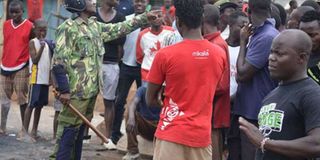Human Rights Watch wants post-poll deaths probed

A police officer calms Obunga residents in Kisumu on August 12, 2017 as protestors opposed the announcing of Uhuru Kenyatta as presidential election winner. Human Rights Watch wants authorities to probe use of excessive force during the protests. PHOTO | ONDARI OGEGA | NATION MEDIA GROUP
What you need to know:
- HRW argues that many witnesses and family members were afraid of speaking up or even going to the hospital.
- Ohers said they could not immediately establish the whereabouts of their relatives.
- Police have consistently refuted claims of brutality or even using live bullets on protesters.
A rights watchdog is calling on Kenyan authorities to investigate the use of excessive force which it argues led to the killing of at least 10, including a six-month old baby in Kisumu County alone.
However, in its latest report, Human Rights Watch (HRW) Monday indicated that the death toll in Kisumu could be higher.
It argues that many witnesses and family members were afraid of speaking up or even going to the hospital, while others said they could not immediately establish the whereabouts of their relatives.
Mr Otsieno Namwaya, the Africa researcher at HRW pointed out that the police in Kisumu and Siaya counties engaged in serious human rights violations during post-election protests that included house-to-house operations.
“The brutal crackdown on protesters and residents in the western counties, part of a pattern of violence and repression in opposition strongholds, undermined the national elections,” said Mr Nyamwaya.
On the night of August 11, residents of Dago Village, 25 kilometres north of Kisumu, said police started firing at villagers strolling on the road unaware of the protests in other parts of Kisumu.
SHOT
In the process, they said a police officer shot 21-year-old Vincent Omondi Ochieng, who was working with Elections Observations Group (Elog).
In Siaya County, police dispersed crowds of protesters at market centres along Kisumu’s Busia Road and pursued them into villages, throwing teargas into homes and beating residents.
In the same county, police fatally shot a protester near Siaya Town and beat a 17-year-old boy to death in the outskirts of Ugunja, as they pursued crowds of protesters into the villages.
And even as people were injured, HRW says many of the wounded did not go to hospital for treatment for fear of being further targeted or arrested.
“As of August 17, at least 92 people with serious injuries, including three women who said police raped them, had not sought any medical help, according to Edris Omondi, the chairperson of the makeshift Kisumu County Disaster Management Centre that was registering those affected by the violence and by police abuses.
“Some of them have very serious injuries like broken legs, arms and ribs. Others cannot walk or eat at all and they will need urgent medical attention,” added Mr Omondi.
Researchers for HRW say they interviewed 43 people including survivors of police beatings and shootings in Kisumu and Siaya counties, examined bodies in mortuaries in Kisumu and Siaya counties as well as visited victims at Jaramogi Oginga Odinga Teaching and Referral Hospital in Kisumu.
Residents of Obunga, Nyalenda, Nyamasaria, Arina, Kondele and Manyatta neighbourhoods in Kisumu told HRW that during the house-to-house operations, officers broke down doors, beat residents, stole money, phones and television sets and sexually harassed women.
“Many town residents fled to a nearby school for the night, only to return to find their possessions looted, presumably by police as police denied any role in the looting and claimed that criminals were responsible,” says the report.
Police have consistently refuted claims of brutality or even using live bullets on protesters.
Nyanza Regional Coordinator Wilson Njega argued that the public should await investigations by the Independent Policing Oversight Authority before laying blame on anyone.




